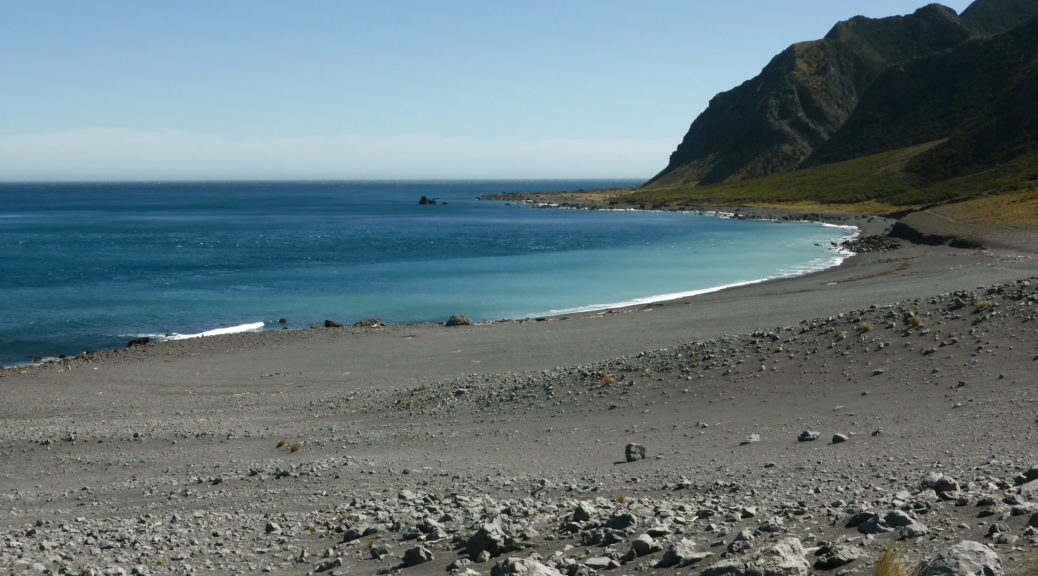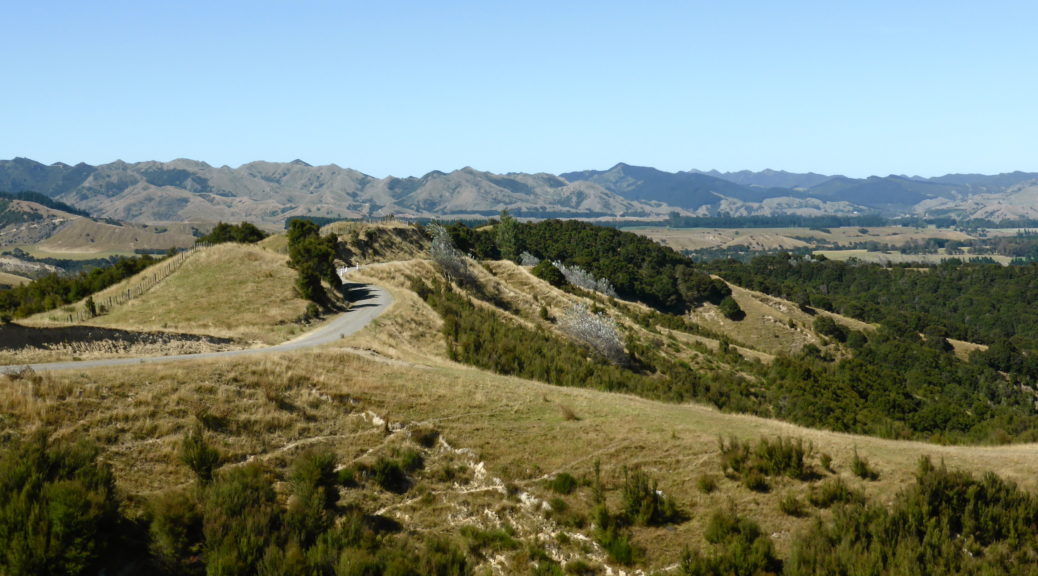Through the summer, Josh and I occasionally mooted a mountain-biking trip away without getting further than riding local trails. With the end of daylight saving fast approaching we were running out of time. Easter weekend was the last opportunity, but I had a bikepacking trip planned for most of it. Good Friday it was to be, provided the weather forecast was amenable to a big day of riding.
Having ridden it twice in different bikepacking events, I’ve long wanted to ride the Timber Trail unloaded and with suspension. Josh had never ridden it; so it was settled. But to help with logistics, we thought it the best use of our time to ride it there and back and save the need for a shuttle. What’s an extra eighty-odd kilometres of trail and a big hill when you’ve just done the same in the opposite direction?
Sleeping poorly in the cabins at the Pureora trailhead, we needed an early start to ensure we’d finish in daylight and I could get to Rotorua in reasonable time. I was pretty sure it had been raining a bit all night, and getting up at five there was sufficient evidence to suggest I was not mistaken. After a big breakfast of bacon and eggs (normal for me, a foreign concept to Josh that I was hoping would slow him down a bit) we were off at six into the dark and rain.
Through twisty dark turns we began the ascent of Mt Pureora, a nicely graded climb up to near 1000 m. The lush native forest, for which the trail is known, kept most of the rain off us; but the canopy could do nothing for all the water spraying from under our tyres. It was bright enough, through the cloud, to turn our lights off as we contoured along towards the highest point. No views of Lake Taupo in the gloom; at least we could descend in the wet by natural light. It stopped raining and eventually it was dry enough to remove all our waterproof layers.
 With the rain, and then the tight schedule, my camera stayed away most of the day. This only goes to show how the inside of my legs were filthy, while the out-side of my socks stayed bright.
With the rain, and then the tight schedule, my camera stayed away most of the day. This only goes to show how the inside of my legs were filthy, while the out-side of my socks stayed bright.
 Josh probably contemplating how much he’ll have to wait for me as the day progresses. A brief stop for a snack at the shelter I slept in the previous time I was here.
Josh probably contemplating how much he’ll have to wait for me as the day progresses. A brief stop for a snack at the shelter I slept in the previous time I was here.
The trail stayed wet, but it was generally in better repair than November. The day cleared nicely and we didn’t see any other riders until well after halfway and passing the Timber Trail Lodge. The first riders were a group of four on e-MTBs. It’s satisfying, if a little tiring, catching up and passing e-bikes on climbs.
Nearing the Ongarue Spiral I realised I was getting sore wrists as my front suspension was really not working. I rode most of the remaining hundred kilometres with it locked out – so much for riding on a full-suspension bike (c.f. a fully rigid bike). It was not until the next day I figured out what must have been causing the unusual knee pain my left leg was giving me.
By half-eleven we were at the opposing trailhead, stopping for half an hour to lunch in the sun and top up water supplies. We figured five hours and twenty minutes (including stops) was not bad going considering the dark and rain we started in, and the muddy wet trail. Turning we had the more difficult leg to conquer, our lunch spot was almost four hundred metres lower than where we would finish. Continually revised calculations of average speed and distance remaining had me confident we’d get back in plenty of time.
It was surprising just how much the track dried out in the afternoon. We passed many people riding in the opposite direction, including those e-MTBs just after discussing their whereabouts, all out enjoying the splendid weather and native forest. Halfway back we were making good progress and Josh still had far too much energy. With just less than thirty kilometres to go there were a couple of steeper pitches that really took a lot of energy out of me; as my single chainring has thirty-two teeth and I’m not running a dinner plate on the end, I ran out of gears and really ground up these pinch climbs.
 There are quite a few photos from Josh where he’s obviously waiting for me!
There are quite a few photos from Josh where he’s obviously waiting for me!
I slowed significantly, even though the last fourteen kilometres of climbing was rather gentle. Josh was regularly waiting for me. I hadn’t completely had it, but was definitely slow and nursing my knee. Finally, the highest point arrived. After a sublime downhill to Pureora and lovely trail over the last few kilometres, I became convinced that south to north is my preferred direction for riding the Timber Trail – even if has significantly more climbing.
I can’t pretend I wasn’t just a little relieved to hear Josh finally start to sound a bit tired; it only took eleven and a half hours, a hundred and fifty-five kilometres and almost three thousand metres of climbing. Waiting for me probably didn’t help either! Still, we made it – well pleased to complete in twelve hours with no real problems. Well, my knee is still sore and my bike is getting the front suspension serviced; but trifling matters compared to a great day out. One day I’ll ride that trail slowly and bother to read all the informative signs!






 Met by this as the end of the road I hoped it wasn’t a sign of the next twenty-five kilometres.
Met by this as the end of the road I hoped it wasn’t a sign of the next twenty-five kilometres. Originally a Forest Service hut, from back in the days this was a state forest, it’s a simple hut in good condition.
Originally a Forest Service hut, from back in the days this was a state forest, it’s a simple hut in good condition. Within not much distance, and with a bit of energy spent, the hut was a speck down there in the centre of the frame. This about a fifth of the way up the climb.
Within not much distance, and with a bit of energy spent, the hut was a speck down there in the centre of the frame. This about a fifth of the way up the climb. This doesn’t look too bad…
This doesn’t look too bad… Oh, the trail goes up beside a cliff. Brilliant.
Oh, the trail goes up beside a cliff. Brilliant. Nice and rocky too – a good work out for the upper body.
Nice and rocky too – a good work out for the upper body. Views east across to the Rimutaka Ranges.
Views east across to the Rimutaka Ranges. But it did lead to views such as this looking across Palliser Bay.
But it did lead to views such as this looking across Palliser Bay. Open farmland took me closer to Cook Strait, and gave views of the South Island.
Open farmland took me closer to Cook Strait, and gave views of the South Island.
 One last super steep bit to get down to the coastal road, which may involved an elegant running jump from the bike as I lost control on the sketchy gravel.
One last super steep bit to get down to the coastal road, which may involved an elegant running jump from the bike as I lost control on the sketchy gravel. Blown all the way to Cape Palliser, I skipped climbing the big staircase in cleats – having done so on
Blown all the way to Cape Palliser, I skipped climbing the big staircase in cleats – having done so on  The track became gravelly and rose a bit give a slightly higher vantage point.
The track became gravelly and rose a bit give a slightly higher vantage point. White Rock sitting across the bay. I turned north and inland at about that place.
White Rock sitting across the bay. I turned north and inland at about that place. I was greeted with a view of an oddly braided river, the Opouawe, which I would follow upstream for sometime with little climbing. Occasionally I could even hide from the wind.
I was greeted with a view of an oddly braided river, the Opouawe, which I would follow upstream for sometime with little climbing. Occasionally I could even hide from the wind. The gravel road riding was great, the wind not so.
The gravel road riding was great, the wind not so.



 Information overload after little but hills to look at since departing. Note made to ride out to the Pahaoa coast next time I’m down this way.
Information overload after little but hills to look at since departing. Note made to ride out to the Pahaoa coast next time I’m down this way. Didn’t stop here for long.
Didn’t stop here for long. This chapel tacked on the end of the village hall was shut up tight.
This chapel tacked on the end of the village hall was shut up tight. The playground didn’t hold my attention for long; although I can report the slide still functions as such.
The playground didn’t hold my attention for long; although I can report the slide still functions as such. That’s better, just what I was looking for.
That’s better, just what I was looking for.
 Suddenly, a fertiliser dump. Somewhere around here…
Suddenly, a fertiliser dump. Somewhere around here… Oh yes, there’s the air strip.
Oh yes, there’s the air strip. Lovely sunshine – however, it was still pleasantly mild, my sleeves didn’t come off all day.
Lovely sunshine – however, it was still pleasantly mild, my sleeves didn’t come off all day.


 A fast descent to Gladstone ensued; the small village bringing back more Tour Aotearoa memories, before I turned off the TA route.
A fast descent to Gladstone ensued; the small village bringing back more Tour Aotearoa memories, before I turned off the TA route.

 At the crest of that climb, Waimarama Beach and Bare Island stretched in front of us.
At the crest of that climb, Waimarama Beach and Bare Island stretched in front of us.  You know it’s bad when your 2.4″ tyres turn into 4″ fat tyres; and you know it has gotten worse when the mud has bridged over the rims.
You know it’s bad when your 2.4″ tyres turn into 4″ fat tyres; and you know it has gotten worse when the mud has bridged over the rims. My new shoes, bought to be more comfortable for hike-a-bike, were getting a bit of walking in – but not looking so new all of a sudden. On the bright side, I did grow a couple of inches in stature.
My new shoes, bought to be more comfortable for hike-a-bike, were getting a bit of walking in – but not looking so new all of a sudden. On the bright side, I did grow a couple of inches in stature. Usually I have plenty of clearance between tyre and fork – not this day.
Usually I have plenty of clearance between tyre and fork – not this day. Nope, that wheel is not turning.
Nope, that wheel is not turning.
